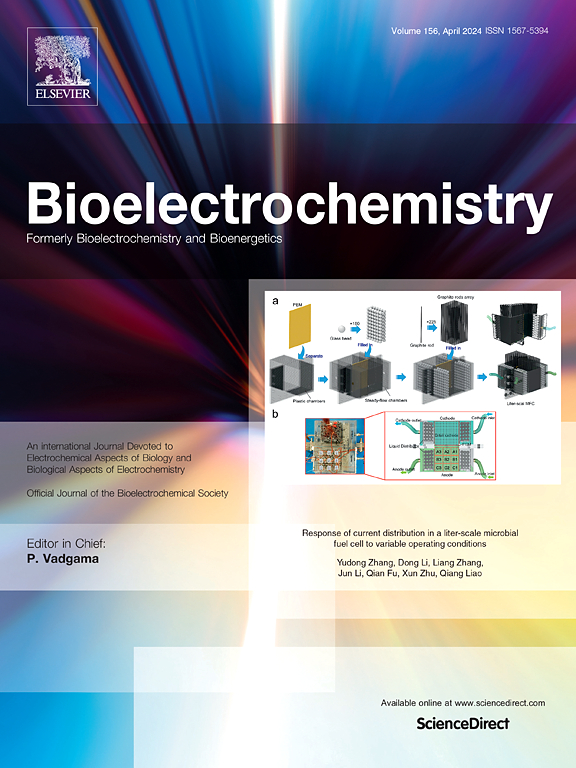Advanced laser-induced graphene-based electrochemical immunosensor for the detection of C-reactive protein
IF 4.8
2区 化学
Q1 BIOCHEMISTRY & MOLECULAR BIOLOGY
引用次数: 0
Abstract
C-reactive protein (CRP) is a critical biomarker for detecting inflammation and forecasting cardiovascular disease. We present an advanced electrochemical immunosensor utilizing laser-induced graphene (LIG)/MXene-gold nanoparticles (Mx-AuNPs) electrode for CRP detection. The Mx-AuNPs nanocomposite, synthesized via in-situ reduction of HAuCl4 by MXene, leverages MXene’s reducing properties for effective nanoparticle deposition, confirmed through scanning electron microscopy. This electrode demonstrates superior electrochemical performance due to enhanced surface area and synergy between LIG and Mx-AuNPs, improving overall electrode conductivity. The A-CRP antibody, immobilized via a cysteamine linker, enables CRP detection. The immunosensor achieves excellent detection across 10 pg mL−1 to 10 µg mL−1 CRP, with a low detection limit of 1.45 pg mL−1, and shows high selectivity for CRP. This LIG/Mx-AuNPs-based immunosensor is promising for sensitive CRP detection, aiding early cardiovascular disease diagnosis and improving patient outcomes.
基于石墨烯的先进激光诱导电化学免疫传感器,用于检测 C 反应蛋白。
C 反应蛋白 (CRP) 是检测炎症和预测心血管疾病的重要生物标志物。我们介绍了一种利用激光诱导石墨烯(LIG)/MXene-金纳米颗粒(Mx-AuNPs)电极检测 CRP 的先进电化学免疫传感器。Mx-AuNPs 纳米复合材料是通过 MXene 原位还原 HAuCl4 合成的,它利用 MXene 的还原特性实现了纳米粒子的有效沉积,这一点已通过扫描电子显微镜得到证实。由于 LIG 和 Mx-AuNPs 的表面积增大、协同作用增强,这种电极显示出卓越的电化学性能,从而提高了电极的整体电导率。通过半胱胺连接体固定的 A-CRP 抗体可实现 CRP 检测。该免疫传感器对 10 pg mL-1 至 10 µg mL-1 的 CRP 具有出色的检测能力,检测限低至 1.45 pg mL-1,并对 CRP 具有高选择性。这种基于 LIG/Mx-AuNPs 的免疫传感器有望实现灵敏的 CRP 检测,帮助早期心血管疾病诊断并改善患者预后。
本文章由计算机程序翻译,如有差异,请以英文原文为准。
求助全文
约1分钟内获得全文
求助全文
来源期刊

Bioelectrochemistry
生物-电化学
CiteScore
9.10
自引率
6.00%
发文量
238
审稿时长
38 days
期刊介绍:
An International Journal Devoted to Electrochemical Aspects of Biology and Biological Aspects of Electrochemistry
Bioelectrochemistry is an international journal devoted to electrochemical principles in biology and biological aspects of electrochemistry. It publishes experimental and theoretical papers dealing with the electrochemical aspects of:
• Electrified interfaces (electric double layers, adsorption, electron transfer, protein electrochemistry, basic principles of biosensors, biosensor interfaces and bio-nanosensor design and construction.
• Electric and magnetic field effects (field-dependent processes, field interactions with molecules, intramolecular field effects, sensory systems for electric and magnetic fields, molecular and cellular mechanisms)
• Bioenergetics and signal transduction (energy conversion, photosynthetic and visual membranes)
• Biomembranes and model membranes (thermodynamics and mechanics, membrane transport, electroporation, fusion and insertion)
• Electrochemical applications in medicine and biotechnology (drug delivery and gene transfer to cells and tissues, iontophoresis, skin electroporation, injury and repair).
• Organization and use of arrays in-vitro and in-vivo, including as part of feedback control.
• Electrochemical interrogation of biofilms as generated by microorganisms and tissue reaction associated with medical implants.
 求助内容:
求助内容: 应助结果提醒方式:
应助结果提醒方式:


